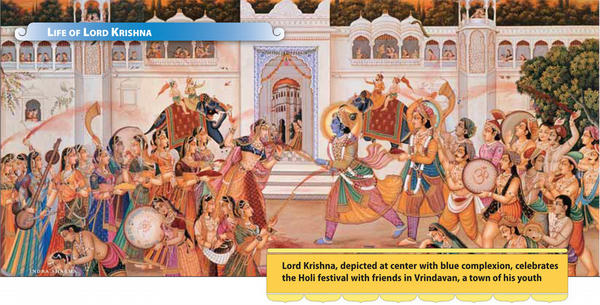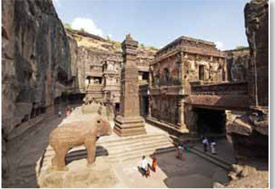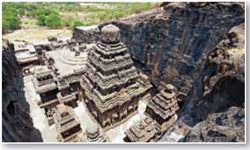Leading a Sacred Life
What You Will Learn...§
Main Ideas§
1. Hinduism permeated the lives of India’s people.§
2. A great devotional movement developed during this time.§
3. The Hindu religion made it possible for anyone to reach God.§
The Big Idea§
India’s rulers and people held a tolerant attitude toward all religions.
Key Terms§
![]() HINDUISM TODAY’S TEACHING STANDARDS§
HINDUISM TODAY’S TEACHING STANDARDS§
If YOU lived then...
It is your first visit to the thriving city of Puhar. When you arrive with your parents, you see not only Hindus but also Jains and Buddhists. You observe Buddhist monks debating philosophical points with Hindus, but afterwards all having snacks together as friends. The king of Madurai, you learn, is a Hindu, but he also shows his religious tolerance by supporting Jain temples and Buddhist monasteries.§
What is the value of religious harmony?§
BUILDING BACKGROUND: Physical evidence of ancient culture is sparse. Wood, paper and cloth disintegrate over time; bricks and stones are recycled. This makes it hard to answer some questions about history. But scientific methods such as carbon dating and DNA analysis are giving new data and correcting wrong theories about ancient times.§
Leading a Sacred Life
Daily life in villages and towns was guided by the principles of righteous living as taught in the Hindu scriptures. Every day began with a time of worship in the home shrine. Temples were the center of village and city life. Families visited them to worship God and participate in festivals and celebrations which were held throughout the year. Holy men and women were honored. One’s daily work was considered sacred. The people respected all the religions.§
Truth is One, paths are many
Most kings of this period were Hindus; some were Buddhists and Jains. With rare exceptions, all supported the various religions during their reign. A Rig Veda verse declares: Ekam sat vipra bahudha vadanti. “Truth is one, sages describe it variously.” This means that there are different ways to speak of the One Truth that is God.§
The Rashtrakuta rulers, for example, not only patronized Saivism and Vaishnavism, but also supported Jainism and Buddhism. Rulers of the period welcomed Christians, Jews, Muslims and Parsis and encouraged them to settle in their kingdoms and practice their faiths. This policy maintained religious harmony in society and even aided international trade.§

Evolution of temple worship
From ancient times, Vedic fire worship rites, called yajna, had been practiced. Families continued to perform these rites at home each day. Rulers across India held spectacular Vedic ceremonies, including coronations and other royal celebrations. Scholars believe that the devotional worship of God and the Gods in small shrines existed alongside or even predated Vedic rites everywhere, especially in South India.§
Since at least the third century bce, devotional worship became increasingly popular. It eventually became the central practice of Hinduism. Some small shrines evolved into great temples with more complex worship, called puja. Puja is the ritual offering of water, food, flowers and other sacred substances to the enshrined Deity. Yajna rites, Sanskrit chanting and verses from the Vedas were all incorporated into the temple rituals.§
The Bhakti Movement
Many Hindu saints of this time preached the importance of devotion to God in what is called the Bhakti Movement. Adoration for God, known as bhakti, stresses one’s personal relationship with the Divine as a love-centered path of spiritual advancement. It complemented meditation and yoga, offering an all-embracing means to enlightenment and liberation from birth and rebirth through divine grace.§
The most famous early saints of the Bhakti Movement are the Vaishnavite Alvars and the Saivite Nayanars. They came from all castes and were a voice for equality. Four of the Nayanars enjoy prominence to this day: Appar, Sundarar, Sambandar and Manikkavasagar.§
While pilgrimaging from temple to temple, the Nayanars composed poems and songs in praise of the loving God Siva. These became part of a massive body of scripture called the Tirumurai. These passionate hymns, composed in the Tamil language, remain popular today in South India. Saints emerged all over India composing devotional songs to Siva, Vishnu, Krishna, Rama and Devi in local languages. There was a massive response to this stirring call of divine bliss.§
Great teachers and philosophers, such as Ramanuja and Yamunacharya, were critical to the Bhakti Movement. They explained how to relate to God through worship.§
ROCK-CUT TEMPLE§
The Kailasanatha Temple to Lord Siva at Ellora, Maharashtra, in West India, was begun in the 8th century by Rashtrakuta King Krishna I and completed by his successor. Amazingly, it was carved out of a solid mountain of rock. It took the stone workers 100 years to remove 200,000 tons of rock. The temple, measuring 160 feet by 280 feet, was created in the South Indian style by architects of that region. It was designed to resemble Mount Kailasa, the Himalayan home of God Siva. Along the same rock cliff are 34 caves that were excavated from the solid rock between the 5th and 10th centuries. They served as monasteries and temples. Twelve were built for the Buddhists, 17 for Hindus and five for Jains. The fact that these were all built in the same complex testifies to the religious harmony and diversity of the period.§
Why do you think the king went to so much time and expense to build this large temple?§
Adi Shankara§
The guru Adi Shankara (788-820) developed the philosophy of Advaita Vedanta during this time. In summary, his philosophy can be stated as: “Brahman (the Supreme Being) is the only truth. The world is an appearance. There is ultimately no difference between Brahman and the atma, or individual soul.” He taught this philosophy across India. He established four monastic centers which remain influential today. His teachings and the Bhakti Movement together brought back many Jains and Buddhists to Hinduism.§
Temple worship
All over India great Hindu temples were built or expanded between 300 and 1100 ce. Many are at the center of large cities, such as Varanasi on the Ganga in the North, and Madurai in the South, and remain powerful places of worship.§
In the temples, the people worshipedtheir chosen Deity with great devotion and paid respects to the many other enshrined Deities. The priest conducted the holy rituals, but did not stand between the devotee and God.§
Temple worship was defined in great detail in the Agamas and parts of the Puranas. The refined art of building with stone, brick and other materials was the subject of the Vastu Shastras. These books on architecture cover temple design, town planning and house construction. All these texts are in Sanskrit. The Agamas include rituals and Sanskrit chants for every act connected with the temple, from its conception and construction to the details of daily worship.§
Temples were central to the social and economic life of the community. Large temples also served as centers for education and training in music and dance. Over the centuries, many temples acquired agricultural land and great wealth. During festivals, thousands of people pilgrimaged to the famous temples. This flow of visitors helped the local economy and spread cultural practices and religious belief.§
The Purana Scriptures
Puranas are dedicated to a particular Deity. Each contains a description of the origin of the universe, lists of kings, Hindu philosophy and traditional stories about the Gods and Goddesses. Among the most important Puranas are the Bhagavata, Vishnu, Siva and the Markandeya, especially for its Devi Mahatmya section. The Bhagavata narrates the greatness of Lord Vishnu and His ten avatars, of whom the two most important are Lord Rama and Lord Krishna. The Siva Purana extols the four-fold path leading to oneness with Lord Siva: service, worship, yoga and wisdom. It also explains “Namah Sivaya,” regarded by Saivites as the most sacred of mantras.§
The Puranas record an important feature of Hinduism, the assimilation of different ethnic and religious groups. They tell us that earlier migrants into India, such as the Greeks, Persians and central Asian peoples, including the Hunas, had been completely absorbed into Indian society and Hindu religion. Various tribes were also brought into the mainstream and their beliefs and practices assimilated. The stories of these people are recorded in the Puranas.§
Ramayana and Mahabharata
You read in chapter one about the two great historical tales of India, the Ramayana and the Mahabharata. These epics were revised into their present form and gained popularity all over India, and beyond, during our period. They played a crucial role in the development of devotional Hinduism. Unlike the Vedas, which could be understood only by those who studied Sanskrit, the epics were retold into local languages. Drama, dance, song, painting and sculpture based on the epics became the main means of teaching the Hindu way of life.§
During our period, Hinduism and Buddhism spread to Burma, Indonesia, Malaysia, Vietnam, Cambodia and Thailand. It was made popular in these countries through the epics and other Sanskrit texts.§
CHAPTER SUMMARY
The time from 300 to 1100 ce was a golden age in India. Its prosperity, stability and religious harmony encouraged scientific and artistic achievements that set standards for the entire world. Devotional Hinduism developed in a powerful manner. Through songs and stories, it brought Hindu principles and values into the languages of the common people. Temples became popular centers for worship of Gods and Goddesses. The Puranas, Ramayana and Mahabharata provided an abundant library of history, philosophy, religious practices and moral teachings in stories that were passed from generation to generation. This great devotional tradition inspired and sustained the people in their daily life, as it continues to do today.§
REVIEWING IDEAS, TERMS AND PEOPLE§
- a. Explain: How did Hindu rulers show tolerance?
b. Define: What is bhakti?
c. Elaborate: What is the purpose of the temple priest? - List: Name three important Puranas.
- a. Explain: What does assimilation mean?
b. List: What peoples were assimilated into Hindu society? - a. Explain: What is the Bhakti Movement?
b. Explain: What caste did its saints belong to?
c. Elaborate: What are the ways the Ramayana and Mahabharata are presented today?
- Explain: Why do you think the Bhakti Movement became popular all across India?
Hindu temple worship continues to be performed in modern times, using Sanskrit chanting and following instructions from the Agama scriptures.§
The Ramayana and Mahabharata continue to enrich religious life. They have even been made into popular movies and TV programs.§
ACADEMIC VOCABULARY§
adoration§
deep love and respect§
Saivite§
worshiper of Siva§
Vaishnavite§
worshiper of Vishnu§
guru§
teacher§
avatar§
the Supreme Being appearing in human form§
yoga§
practices that bring union with God§
mantra§
sacred sound§
assimilation§
the absorption and integration of a people, idea, religion or culture into a society§
epic§
a long poem about herioc deeds and people§





